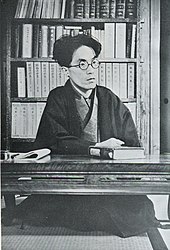Shimaki Kensaku
Shimaki Kensaku ( Japanese 島 木 健 作 , civil: Asakura Kikuo ( 朝 倉 菊 雄 ); born September 7, 1903 in Sapporo ; † August 17, 1945 ) was a Japanese writer.
Shimaki participated in the literary magazine Kunugi no Mi ( 櫟 の 実 ) from 1918 and published tankas and essays under the name Asakura Tengai ( 朝 倉 天涯 ). From 1925 he studied at the Imperial University of Tōhoku . In order to finance his studies, he had to work beyond his strength and contracted tuberculosis.
He left university and joined the Japanese labor movement. In 1927 he became a member of the Communist Party . He was incarcerated from 1928 to 1932 on the basis of the Peacekeeping Act .
He processed his experiences in prison in the highly regarded novel Rai ("Leprosy, Leprosy"), which appeared in 1934 in sequels in the literary magazine Bungaku Hyōron ( 文学 評論 ). Several novels were published in quick succession up to his death at the age of 41.
Works (selection)
- Rai ( 癩 ; 1934)
- Mōmoku ( 盲目 ; 1934)
- Goku ( 獄 ; 1934)
- Rhyme ( 黎明 )
- Saiken ( 再 建 ; 1937)
- Seikatsu no Tankyū ( 生活 の 探求 ; 1937)
- Manshū Kikō ( 満 洲 紀行 ; 1940)
- Ishizue ( 礎 ; 1944)
- Akagaeru ( 赤 蛙 ; 1946)
swell
Individual evidence
- ↑ 青 空 文庫 作家 別 作品 リ ス ト : No.8 . Aozora Bunko , accessed November 20, 2018 (Japanese).
| personal data | |
|---|---|
| SURNAME | Shimaki, Kensaku |
| ALTERNATIVE NAMES | 島 木 健 作 (Japanese); Asakura Kikuo (real name); 朝 倉 菊 雄 (Japanese, real name); Asakura Tengai (poem pseudonym); 朝 倉 天涯 (Japanese, poem pseudonym) |
| BRIEF DESCRIPTION | Japanese writer |
| DATE OF BIRTH | September 7, 1903 |
| PLACE OF BIRTH | Sapporo |
| DATE OF DEATH | August 17, 1945 |
